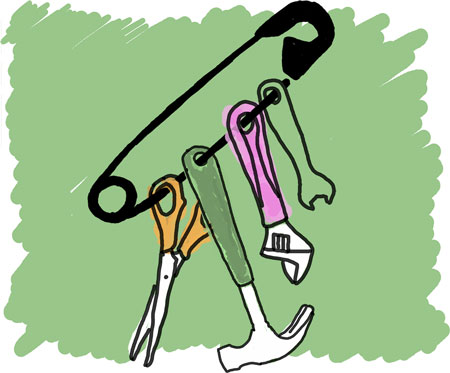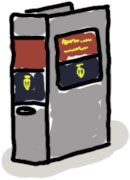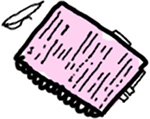However they are, each writer’s tools are forged for his personal use and will help him adopting a consistent routine after much testing and discarding.
In this article I will talk about the tools I use on a daily basis, hoping they will be useful for you too. You will notice that there is one tool (the most important tool for a writer) that is missing in this list, but I think it deserves a separate post.
 1. MailChimp
1. MailChimp
web, Android, iOS | Use: newsletters
If you already have or are building a readers base and you don’t use MailChimp, you are missing a great opportunity. With this application you can, easily and for free:
- Organize your contact lists.
- Create emails with customizable templates that adapt fluidly to the receiving devices.
- Get relevant metrics on the impact of your newsletters in real time.
- Promote opt ins for your contact lists.
And all this without forgetting the great golden rule of online marketing: SPAM, NO THANKS.
2. Keep Google

You may use Evernote or other similar applications to take and keep notes. But these applications allow so many editing and classification options that they may make the task more difficult than necessary, blocking the spontaneous process of taking notes.
That’s why I use Google Keep to take notes on the go. One new note, one click. And the notes just order in chronological order as post-its. There are only a few available options: adding an alarm (so that the device will remind you to review it), adding pictures, taking voice notes, creating item lists, and assigning colours to the notes.
In my opinion, the best part of Google Keep is that you won’t need to worry about classification when you take the note, which on the other hand forces you to review the annotations at some point afterwards. You can check your notes on the web too, so you can set aside a moment of your day to revise and develop them. It’s better to take a few notes and use them later than being thorough but never go back to that information again.
3. StayFocused
Google Chrome extension | Use: productivity

Have you ever found yourself in front of a Youtube cat video without even knowing how you ended up there? Or maybe you feel weak for some social network or website where you lose too much time?
At some point, you may want to consider regulating your own use of the web with an extension like Stay Focused, where you can make a list of “vetted sites” along with the maximum time you are willing to spend on them every day.
If you want to see a video on Youtube you’ll do it anyway (just disable the extension), but maybe, if something reminds you that you are about to waste your time, you’ll think twice about it.
4. Google Drive
web, Android | Use: text editor

For me, the most valuable aspect of Google Drive is that documents can be exported into universal formats and the cloud guarantees its durability over time (or at least, while this is possible). Plus, it’s just as versatile as a blank page, so you can give the documents any use you want.
I have some times used applications specifically designed to reviewing movies, writing a diary or saving drafts, but I came to realize that the easiest thing to do is creating a Google Drive document, formating it as you want and arrange it into folders. Thing about durability and information retrieval. What is easier and faster, classifying dozens of Evernote notes into dozens of notebooks, or just creating a document for each topic on Google Drive?
On the other hand, I’m not too sure if Google Drive is a great tool for writing long texts. I can’t tell exactly where the threshold is, but once I tried to finish a book (of about 50,000 words) in Google Drive, and it just collapsed. There comes a moment when you can no longer copy and paste large blocks of text without making the application crash.
5. DuckCapture
desktop | Use: screenshots

If I see an image that catches my attention (a book cover, a website layout, an anonymous face that inspired me, a picture of a place…), I just click on the DuckCapture icon in my Windows taskbar and the screenshot saves to a file in the desktop. Then I can rename the file and classify it into the appropriate folder.
This method may seem impractical, but other ways to save this kind of materials on the go, such as copying URL links, may not be trustful. You have to take into account that many services you might be using today to save your bookmarks may stop working one day. Besides, a URL that works now may be removed by the web creator anytime.
I don’t see the point in taking time to saving and classifying things and then never going back to them. I want to have that information on hand so that I can make the most of it, and that’s why I like taking notes and screenshots and keeping them on universal formats such as jpg or txt.
6, 7. Sublime Text and Calibre
Sublime Text and Calibre for desktop | Use: text editor, ebook editor

For me, this is an inseparable combination. I don’t need anything else to edit my stories in any format I want to let people read them on any possible device.
Sublime Text is a text and source code editor, which means you can use it to code a wide variety of things, such as webpages or applications.
Editing an ebook with html (and CSS for styling) can be a simple of difficult process, depending on how complex would you like your layout to be. Once you have your html file, you have to zip it with your images and then use Calibre to convert it into a mobi, epub or pdf file, ready to be read in any device.
Calibre has a lot to improve, notably in relation to usability, but once you have practised and got used to it, the number of configuration options will amaze you.
8. WordReference

As a writer you will need a good dictionary on a daily basis, but also a good tool to resolve grammatical doubts while you are writing.
If you don’t find a quick answer at the dictionary, you can check the reference pages at WordReference or start a discussion in the forums yourself.
It involves very little effort, and even if you need the information immediately, you’ll soon see many kind users involving in the thread and trying to clear your doubt.
9. 99-cents store notebook

In my experience, you won’t need to spend twenty dollars on a Moleskine to write a book. Just take a walk to your average stationery shop around the corner and you’ll be surprised by the amazing range of notebooks they have. And the next time you are about to download the next trendy application for writers… resist the temptation!
Don’t obsess over trying everything. Too often new applications happen to be rehashes of things that already exist (and that you are probably already using), and they will provide little value and will only make you waste your time. The most important thing is choosing tools that will help you in your work.
Share your thoughts! What tools are useful for you in your daily work as a writer?
Leave a Reply